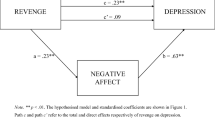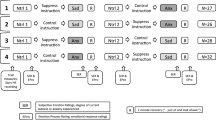Abstract
Several situational and individual aspects of interpersonal mood induction were investigated in an attempt to elucidate the mechanisms by which depressed mood is “transmitted” from one individual to another. Eighty-four psychology students interacted with confederates previously trained to enact one of three mood states — depressed, neutral, or elated. Participants were randomly assigned to same-sex confederates in one of two roles — helper or stranger, resulting in a 3×2×2 design. Mood and self-esteem were independent variables assessed prior to the interaction. Mood, perceptions, and reactions to the confederate were dependent variables assessed following the interaction. Results indicated induction of depression and anxiety in participants exposed to “depressed” confederates, and induction of hostility following interaction with “elated” confederates. Induction of depression and hostility were significantly attenuated in participants in the helper role as opposed to person perception role, while the concept of individual vulnerability to mood induction was not supported in this study. Rejection of depressed persons was only modestly associated with negative mood induction. Thus, role components of the situation affected mood induction more than did individual participant differences. The results and their implications for therapists and family members of depressed individuals are discussed within the framework of Lazarus's cognitive model of emotional arousal.
Similar content being viewed by others
References
Beck, A. T.Depression: Clinical, experimental, and theoretical aspects. New York: Harper & Row, 1967.
Chaikin, A. L., & Derlega, V. J. Liking for the norm-breaker in self-disclosure.Journal of Personality 1974,42 117–129.
Coyne, J. C. Depression and the response of others.Journal of Abnormal Psychology 1976,85 186–193.
Hammen, C., & Peters, S. D. Differential responses to male and female depressive reactions.Journal of Consulting and Clinical Psychology 1977,45 994–1001.
Hammen, C., & Peters, S. D. Interpersonal consequences of depression: Responses to men and women enacting a depressed role.Journal of Abnormal Psychology 1978,87 322–332.
Howes, M., & Hokanson, J. E. Conversational and social responses to depressive interpersonal behavior.Journal of Abnormal Psychology 1979,88 625–634.
Lazarus, R., & Launier, R. Stress-related transactions between person and environment. In L. Pervin & M. Lewis (Eds.),Internal and external determinants of behavior. New York: Plenum Press, 1978.
Lewinsohn, P., Mischel, W., Chaplin, W., & Barton, R. Social competence and depression: The role of illusory self-perceptions.Journal of Abnormal Psychology 1980,89 203–212.
Youngren, M. A., & Lewinsohn, P. The functional relationship between depression and problematic interpersonal behavior.Journal of Abnormal Psychology 1980,89 331–341.
Zuckerman, M., & Lubin, B.Manual for the Multiple Affect Adjective Check List. San Diego: Educational and Industrial Testing Service, 1965.
Author information
Authors and Affiliations
Additional information
The authors gratefully acknowledge the contributions and talents of Bill Dorfman, Mike Harrington, Ginger Johnson, Anita Navarra, and Debbie Illman.
Rights and permissions
About this article
Cite this article
Marks, T., Hammen, C.L. Interpersonal mood induction: Situational and individual determinants. Motiv Emot 6, 387–399 (1982). https://doi.org/10.1007/BF00998192
Issue Date:
DOI: https://doi.org/10.1007/BF00998192




